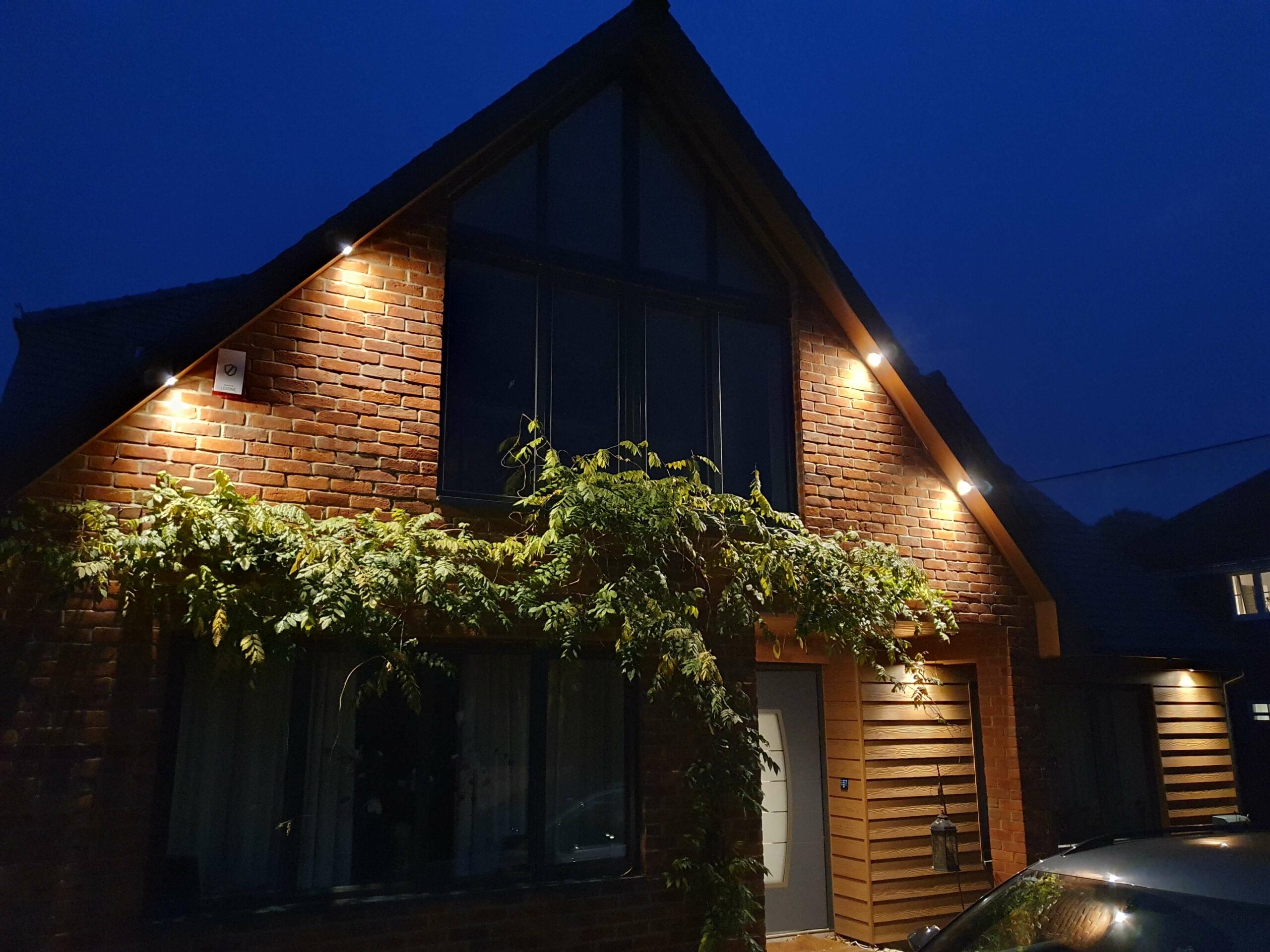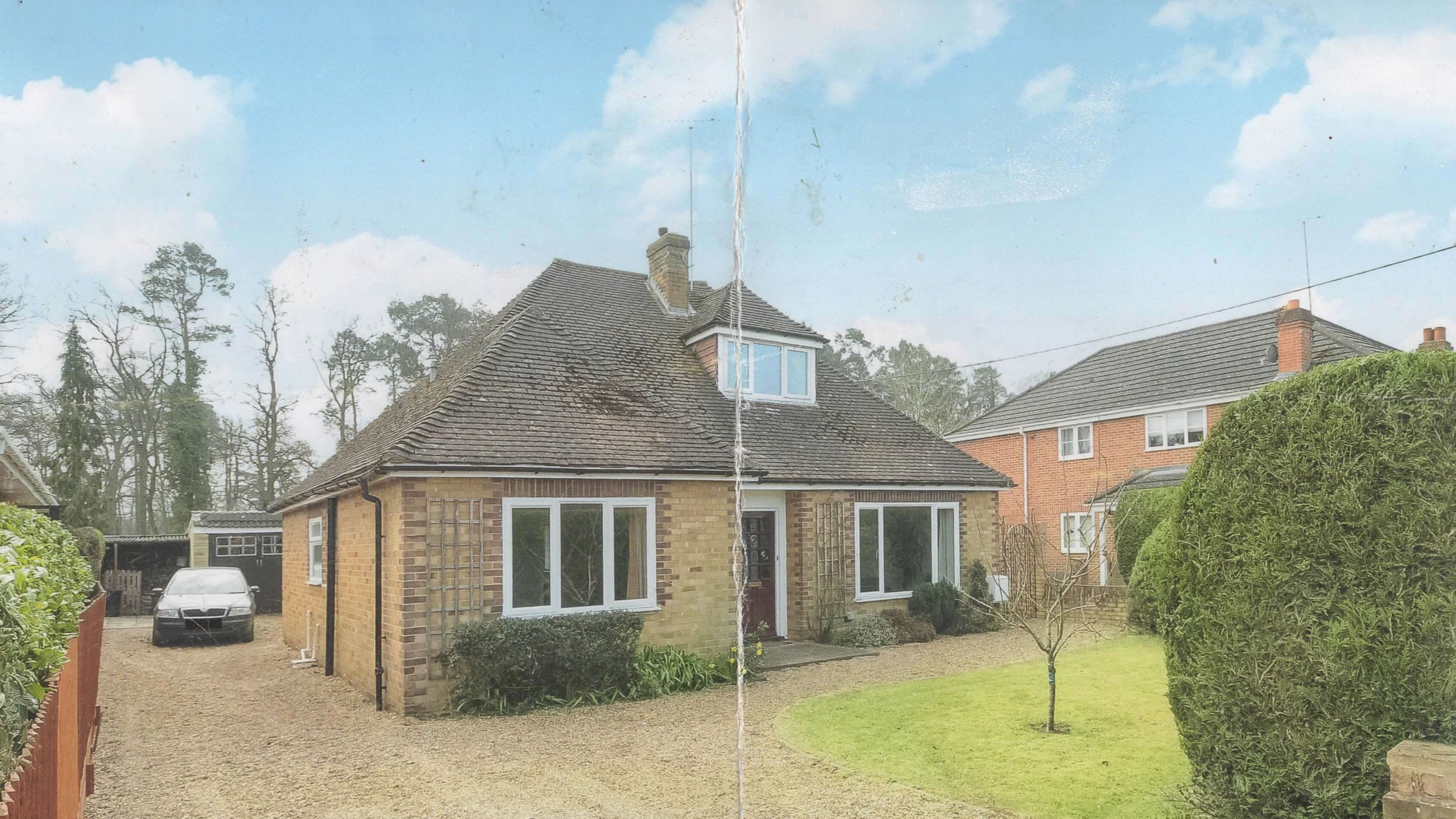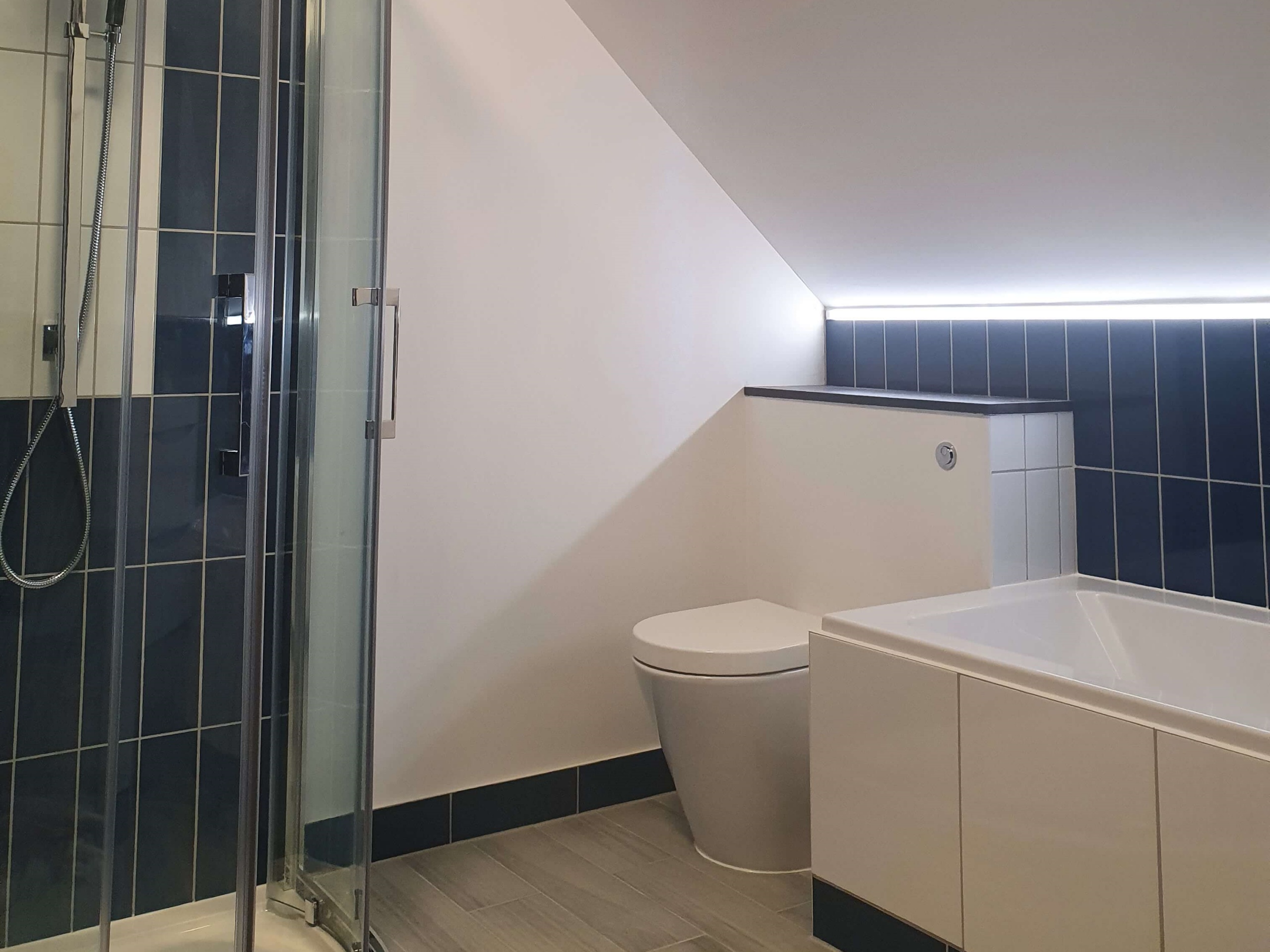
Energy Efficient Berkshire Home
Bruce from Birch Hill Developments (Loxone Silver Partner) has been building houses since 2000 (with each project he has been trying to become greener) – using sustainable materials and making sure that the home is maintenance-free going forward. With a fresh new build underway for Bruce’s own home – energy efficiency and self-sufficiency were key for the build. Being an automation specialist installer, utilising Loxone, it was instantly clear that Loxone was to be the brain of the operation. In his home Loxone is used to ensure the system’s maximum efficiency and smart nature.
It is really remarkable what Bruce has implemented. So, we caught up with him to explain the various elements of the system…


The System:
Loxone Miniserver (The brain of the operation) – Is set up for this install to use energy in the most efficient way possible and this just seamlessly happens in the background by a priority list of where to direct energy at different thresholds. The Miniserver does so much more, but with this blog’s angle on energy, that will be the focus of the writing.
Solar thermal – Solar thermal on its own is very efficient, with the added benefit of summer surplus being used to heat the pool. There was a conscious choice not to use solar PV yet, as it is not efficient enough and batteries are expensive, [if there was a smaller battery (still a bit away) solar PV would be warranted] – whereas, what is being done here is relatively affordable in comparison. Solar PV is 20% efficient, so you have to have as many of the panels as possible on your roof, but solar thermal is 72% efficient and uses fewer and smaller panels.
Tank and wood burner unit – There are 5 sensor points in the tank, utilising Loxone 1-wire temperature probes; this allows energy to be redirected by demand, which is played by ear. Just set the numbers for when to bring on the load, and Bruce is currently working on the draft power supply for auto-shutoff. All of the hot water is heated by a woodburning stove (a Woodfire EX17 Panorama DS – German made) and the buffer tank (Energystore – made in Ireland). Different wood obviously has different burn values, which in turn varies and affects the output, but this is all already taken into account.
Bathroom – Again, using temperature probes – the system can register if someone is having a shower or bath – this then brings on the towel rail for 4 hours so that even in the summer, the towels are dried properly despite the central heating not coming on.
Office – The office often had the heating on in the morning when it was not needed, due to the windows in the room having lots of glazing (including on a large flat roof window) and the room being South-East facing. So a < block has been added, to incorporate the solar irradiation from the Weather Service for the upcoming 12 hours, and if greater than 10,000, the system will not bring the heating on when called for. This is because the solar gain will warm the room enough. So on a cloudy day, the heating will still come on as normal. This was linked to the eco input on the Intelligent Room Controller. This will also be done, in the future, for other heavily glazed areas in the house.

– Relays to control 2-way valves (multiple, including both Relay Extension and Coupling Relay)
– Valve Actuator Trees for the underfloor heating
Additional Loxone components include Loxone Touches throughout – to read the temperature in every room where there is underfloor heating, as well as Presence Sensors.
– Air source heat pump
– Solar thermal pump
– Emersion heaters
– Load unit
– 2-way valves and pumps
– Energy meter



The Numbers:
Annual average home energy usage
| House Type | Units in kWh |
| Flat | 9,800 |
| 2-3 bed | 14,900 |
| 5 bed | 21,300 |
| Source – British Gas | https://www.britishgas.co.uk/energy/guides/average-bill.html |
Case study home’s annual energy usage
| Sept 2017 to Sept 2018 (Before renovation and Loxone) | 17,325 kWh |
| 5 bed (260 m2) house and outbuildings (Heated pool in summer too) – Sept 2021 to Sept 2022 | 7,172 kWh |
| Last 6 months of the above period | 2,533 kWh |
| Rainwater harvesting tank (7,500L) | Saves 700L water a week |
There is no denying the numbers say it all, with an average energy saving over the last year of 58.6% compared to pre-renovation (Loxone installation) (this last year also included time with poor insulation). A more realistic representation of energy usage has come in the last 6 months, utilising just over 2,500 kWh, with the really interesting time coming up … this winter.
These savings are incredible vs the average house, with a potential annual saving of between 12,000 and 16,000 kWh of energy a year compared to British Gas’ average 5 bed house numbers, which in turn saves money and reduces the carbon footprint of the home. This provides real insight into how effective Loxone is as an energy management solution.
The numbers:
Average home energy usage
| House Type | kWh per year |
| Flat | 9,800 |
| 2-3 bed | 14,900 |
| 5 bed | 21,300 |
Source: British Gas
Case study home
| Sept 2017 to Sept 2018 (Before renovation and Loxone) | 17,325 kWh |
| 5 bed (260 m2) house and outbuildings (Heated pool in summer too) – Sept 2021 to Sept 2022 | 7,172 kWh |
| [Last 6 months of the above period | [2,533 kWh] |
| Rainwater harvesting tank (7,500L) | Saves 700L water a week |
There is no denying the numbers say it all, with an average energy saving over the last year of 58.6% compared to pre-renovation (Loxone installation) (this last year also included time with poor insulation). A more realistic representation of energy usage has come in the last 6 months, utilising just over 2,500 kWh, with the really interesting time coming up … this winter.
These savings are incredible vs the average house, with a potential annual saving of between 12,000 and 16,000 kWh of energy a year compared to British Gas’ average 5 bed house numbers, which in turn saves money and reduces the carbon footprint of the home. This provides real insight into how effective Loxone is as an energy management solution.
Before

After

Bruce’s favourite implementations:
- Automatic shading and electric windows opening and closing e.g. in the office, the large flat roof window opens and closes (gradations will be added in), and blinds go up and down automatically in relation to the room and the weather. Great for when on a long Zoom call.
- We have inward opening French doors and windows, with automatic binds. Sometimes it isn’t obvious that the windows are even open or tilted. So, we’ve added contacts to the doors so that the automation of the blinds (as well as manual control) is prevented when the doors are open. It is a super useful feature.

- Another great addition to the system has been the thermal blackout blinds, which reduce heat loss in winter (saving money) and room climate control in summer. The roller blinds (230V) are controlled by Nano 2 Relays Tree and the Triangle blinds (24V) are controlled by Nano Motor Controllers Tree. These 24V blinds are also powered straight from the Loxone Power Supply along with the 24V fans dispersing warm air above the Woodburning Stove. Again, Bruce notes that normally these blinds would have a seperate controller and power supply but with them integrated into the Loxone system there is no need for this clutter.


Bruce’s ambition for the future of the project:
Even with all this impressive smart energy usage, Bruce views the project to be in its infancy. He has big plans for the future, to continue to develop and grow the home’s efficient use of energy, with an ultimate goal of complete self-sufficiency. The future plans are:

- Trying to do Modbus from the air source heat pump
- Solar irradiation values and map them across the year to bring on alternatives to solar when the sun is lower in the sky. Also, a text note to advise on lighting the fire (which will be tracked) and if not done ASHP (air source heat pump) turns on as the 3rd choice.
- Fans above the stove to spill heat into the lounge and dining room. Similarly in the upstairs bathroom, where the flue passes through a boxed section so as to dissipate the heat more effectively.
- Text or caller function if there is an issue with the system (for example, the pump itself). Nice safety feature to add in, to make a safe system even safer.
- Bring cooler water back from the pool, to flow around the underfloor pipes in summer for cooling, which is better for energy efficiency and the environment compared to A/C.
- Finding a solution to stop automatic shading in the living room when the wood-burning stove takes the room temperature over comfort. This will probably be done using temperature sensors on the flue to disable the shading function.


Our construction has always been timber frame, underfloor heating, powered by gas/oil/wood/ground source/air source heating and hot water. With an emphasis on internal air flow and good insulation practices.
The current bungalow was leaking heat everywhere, walls, floor, doors, windows, roof, etc. The cost of renovating the house was impractical for the desired outputs and demolition and rebuild seemed the best option. It was then decided to try and incorporate an as close to net zero energy house as possible on an affordable budget, that could be replicated in other projects going forwards, if the decision was made to follow that route at inception of the project.
Over the years all the parts of a house seemed to be attracting their own standalone programmers that didn’t really speak to each other and often conflicted with each other. Everything needed a plug-in to the router and a big cluttered box of controllers ensued, from Velux, Blinds, Heating, Lighting Drivers, Alarm, Google, Alexa, along with numerous remotes – which companies love selling as extras for their own products. I was keen to streamline this process and this is where after much research on smart home technologies, we opted to become involved with Loxone as a vehicle to run the whole house with the plan of integrating programmers into one platform, that would be self-supporting and stand alone within its own walls. This has been enabled by Loxone as well as, of course, all the other benefits of Loxone in a house.
This current house at No.3 has now been successful in using Loxone to integrate a very low energy use Heating and Hot water system that includes a Back Boiler on a Wood Burning Stove, with safety overheat features covered, Burn rate damper control, Solar Thermal Hot water, Air Source Heat Pump and Immersion Back up. Loxone Weather and temperature variables are prioritising one system over another (saving energy and money) and also coordinating a Mechanical Ventilation Heat Recovery system along with window opening and closing, curtain and blind control for shading and heat retention. All these features once used as a whole house system, have made some remarkable savings.
The existing bungalow between September 2017 to September 2018 used 17,325 kWh of energy (gas and electric combined). Between September 2021 to September 2022, 7172 kWh of energy was used, solely electric. The new house has no gas supply.
If the house had a standard 9kW Solar Panel system it would exceed net zero, which whilst Loxone doesn’t provide insulation and an airtight building, it is very capable of energy management and efficient usage of heating and hot water around the home. In the summer the excess solar gain has also been heating a swimming pool and maintaining the temperature in the mid to high 20’s from May to October. The existing bungalow had no heated swimming pool either.
Financially there is now no daily standing charge for gas.
I favoured Loxone from an early stage and feel that what I am doing and Loxone logic work very well together and can continue to also develop together.
Interested in Loxone?
Whether you want Loxone installed or you want to start offering your customers Loxone, speak to us about making that happen.

